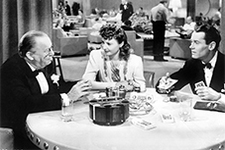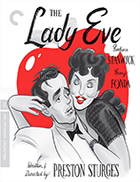The Lady Eve
|  The Lady Eve is writer/director Preston Sturges’s ode to romance as the greatest con game of all. Sturges, always the ironic satirist with a love of great characters and improbably wild scenarios, dreamt up in The Lady Eve a classical Hollywood screwball comedy with such overt overtones about the appeals of dishonesty and criminality that it’s a wonder the Production Code Administration ever let it through. Of course, Joe Breen and the other moral guardians at the PCA were so wrapped up trying to discern the thinly veiled sexual innuendo in Sturges’s perfectly tuned dialogue that they missed how The Lady Eve breaks one of the cardinal rules of the Production Code: the audience’s sympathy should never be “thrown on the side of crime” and a film should never “throw sympathy against goodness, honor, innocence, purity, honesty.” This is, of course, exactly what Sturges does by establishing a romance between a beautiful and wily con artist named Jean Harrington (Barbara Stanwyck) and her prey, Charles Pike (Henry Pike), a naïve young man who is wealthy beyond belief, but only because he was lucky enough to have been born into a family fortune built on Pike’s Ale (“The Ale That Won for Yale”). Charles, nicknamed “Hopsy” in college because of his family background, has little interest in ale. He wants to be an ophiologist, someone who studies snakes, and when the movie opens, he is leaving South America after spending a year “up the Amazon” studying rare reptiles. To get home, he boards the cruise ship Southern Queen, setting off quite a stir, especially among all the women on board who hope to catch his eye and marry into his fortune (one of the movie’s most inspired scenes involves Jean providing a sardonic voice-over narration while watching in a mirror as woman after woman tries in vain to catch the clearly disinterested Hopsy’s eye). Jean and her father and mentor, “Colonel” Harrington (Charles Coburn), immediately set their sights on Hopsy—they know an easy mark when they see one. Jean goes to work on him at once, but the tables are turned on her when her attempts to seduce Hopsy in order to fleece him develops into real love. Sturges isn’t satisfied with this simple turn of events, though, so he introduces a new twist by having Hopsy and Jean’s romance turn sour once he learns that she is a professional card sharp. The story then moves off the cruise ship and into the Pike family mansion in Connecticut, where Jean re-emerges disguised as an English heiress named Lady Eve who then seduces Hopsy again and gets him to marry her only so she can devastate him as retribution for his having deserted her earlier. The Lady Eve, being a screwball comedy, pushes the envelope in terms of plot plausibility, but Sturges’s sophisticated dialogue and the wonderful performances by Stanwyck, Fonda, and Coburn bring us in so close to the characters that we can ignore such utterly far-fetched scenarios as Hopsy somehow not realizing that the Lady Eve is actually Jean (Sturges does exert a great effort to explain why he doesn’t, and he comes close at times to making it credible). However, this is all par for the course in screwball, and we understand that the pleasure in The Lady Eve is not its fidelity to realism and rationality, but rather its rapid pace, witty dialogue, and overall sexiness. And The Lady Eve is, without a doubt, one of Sturges’s sexiest movies (owing in great part to Stanwyck, who glides naturally between sensual sophistication and girlish excitement). Considering the tenor of the times in terms of censorship, it is understatement to say that Sturges got away with a lot. Weaving in numerous references to the Biblical story of humankind’s fall from grace (it is not by accident that Jean takes the name “Eve”), Sturges foregrounds sexuality in a way that few filmmakers dared at the time. Although it appears relatively tame by today’s standards, Sturges’s use of displaced anatomy fetishes (shoes, stockings, etc.) and his comical employment of the blackout ellipsis to suggest what is happening behind closed doors gives the movie, in Andrew Sarris’s words, its “ribaldry and gusto” without ever being “coarse and tasteless.” For example, Jean meets Hopsy by purposefully tripping him in the dining room on the cruise ship and then asking him to come down to her cabin to help her pick out a new pair of shoes because her heel broke off. The sequence in her cabin is a moment of sly sensuality that generates great heat with the simple act of Hopsy changing Jean’s shoes. As Parker Tyler has noted, “In the annals of sex symbolism, a lady’s foot is a truly historic fetish,” and Sturges uses Stanwyck’s for all it’s worth. The shoe changing is a deeply intimate moment—especially for two people who just met each other five minutes earlier—but it is also comical in how it works to contrast Hopsy’s awe-struck innocence and vulnerability with Jean’s street-smart confidence and complete control. The tables, of course, will be turned once Jean lets her defenses down when she falls in love. The Lady Eve features some of Sturges’s most memorable sequences, including my favorite, a card game among Colonel Harrington, Jean, and Hopsy in which the Colonel is aiming to con Hopsy out of all of his money while Jean tries to protect him. Sturges has never been known as a particularly innovative or stylish director visually, but here he constructs an elaborate sequence using editing and camera angles to depict the war of cons between father and daughter as they both cheat for different purposes while Hopsy blindly plays along, thinking he is in the midst of a heated, but perfectly legitimate card game. It’s an interesting scene to view along gender lines, as Jean effectively assumes the typically masculine role of protecting her love interest from harm (in this case, economic harm) and, in a sense, “rescuing” him. Still, when watching The Lady Eve, despite all its romance and pratfalls, it’s hard to get away from Sturges’ themes about corruption and dishonesty, which he had explored more fully in his directorial debut, The Great McGinty (1940). Sturges never fully defends conning people out of their money as a noble way of life, yet he never condemns it, either. He allows Colonel Harrington and Jean to stand on their own merits as human beings, and even though their means of earning a living would be considered “dishonest” by most, even “criminal,” Sturges draws them as such interesting and deeply felt people that it’s impossible to pass judgment on them. On the other side, it’s hard not to feel that naïve saps like Hopsy are simply asking for it when they get taken advantage of. Sturges’s sly commentary seems to be a form of economic Darwinism, in which con artists like Colonel Harrington and others simply feed off the system that makes some people obscenely wealthy. Conning, like any other form of business, is a skill that has its economic rewards in the capitalist system. Yet, the movie wouldn’t work if Sturges weren’t such a good writer who could infuse traditional genre material with such thematic concerns. On the surface, The Lady Eve is a wonderfully enjoyable madcap farce, even though its weakest moments are its most obvious, including a series of pratfalls and slapstick moments that seem almost superfluous when compared to the comical brilliance of the dialogue. The Lady Eve was released in 1941, near the beginning of Sturges’ amazing seven-movie run between 1940 and 1944, in which he seemed to exhaust his creativity in what is still one of the most amazing periods of success for a single filmmaker. Even though his career slowly deteriorated after those five years, during that time Sturges produced a lasting body of work that, at least since the 1970s, has elevated him to the highest ranks of American auteurs. The Lady Eve is but one testament to his cinematic brilliance and lasting impact on the Hollywood comedy.
Copyright © 2020 James Kendrick Thoughts? E-mail James Kendrick All images copyright © The Criterion Collection | |||||||||||||||||||||||||||||||
Overall Rating: 


 (4)
(4)


